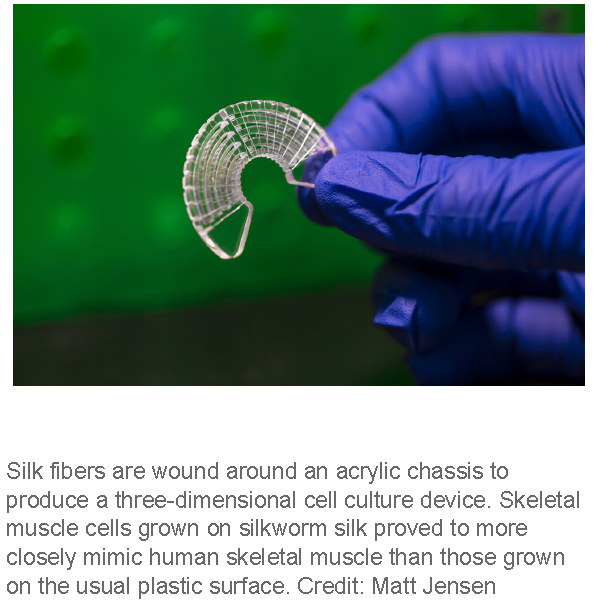博文
研究人员使用蚕丝来模拟肌肉组织
||
研究人员使用蚕丝来模拟肌肉组织
诸平


据美国犹他州立大学(Utah State University, USU)2021年3月9日提供的消息,该校研究人员正在使用蚕丝来生长骨骼肌细胞,改进了传统的细胞培养方法,并有望为肌肉萎缩症提供更好的治疗方法。
当科学家试图了解疾病并测试治疗方法时,他们通常会在平坦的塑料表面上培养模型细胞。但是在二维表面上生长的细胞有其局限性,主要是因为肌肉组织是三维的。因此,美国犹他州立大学的研究人员通过在缠绕在丙烯酸底盘上的丝纤维上生长细胞来开发三维细胞培养表面。该团队同时使用了天然和转基因蚕丝,后者是由经蜘蛛丝基因修饰的蚕所生产的。
以前,天然蚕丝已被用作三维细胞培养模型,但这是转基因蚕丝首次用于骨骼肌建模。USU生物工程系的伊丽莎白·瓦尔吉斯(Elizabeth Vargis)、马修·克莱格(Matthew Clegg)和雅各布·巴尼(Jacob Barney),生物系的贾斯汀·琼斯(Justin Jones)、托马斯·哈里斯(Thomas Harris)和张小丽(Xiaoli Zhang音译)在《ACS生物材料科学与工程学》(ACS Biomaterials Science & Engineering)中发表了他们的发现——Matthew H. Clegg, Thomas I. Harris, Xiaoli Zhang, Jacob T. Barney, Justin A. Jones, Elizabeth Vargis. Silkworm Silk Fiber Bundles as Improved In Vitro Scaffolds for Skeletal Muscle. ACS Biomaterials Science & Engineering, 2020, 6(12): 6853-6863. DOI: 10.1021/acsbiomaterials.0c00987.
与在普通塑料表面上生长的细胞相比,在蚕丝上生长的细胞被证明与人类骨骼肌的模仿更为接近。这些细胞显示出增加的机械柔韧性和增加了肌肉收缩所需基因的表达。蚕丝还促进了肌肉纤维的正确排列,这是进行强健肌肉建模的必要元素。
骨骼肌负责移动骨骼、稳定关节和保护内部器官。这些肌肉的退化可能由于多种原因而发生,并且可能迅速发生。例如,仅固定两周后,一个人可能会失去四头肌的几乎四分之一的力量。必须如此迅速地了解肌肉如何萎缩,必须从细胞水平开始,并逐渐生长出能更好地代表现实的细胞。
USU生物工程学副教授伊丽莎白·瓦尔吉斯说:“我研究的总体目标是建立更好的体外模型。” “研究人员在这些2D平台上培养细胞,这不是超级现实的方法,但是可以为我们提供很多信息。基于这些结果,他们通常会转换为动物模型,然后进行临床试验,其中绝大多数我正在尝试通过开发更现实的正常组织和患病组织的体外模型来补充第一步。”上述介绍仅供参考,更多信息敬请注意浏览原文或者相关报道。

To mimic skeletal muscle tissues in vitro, native and transgenic spider silk/silkworm silks were seeded with C2C12 myoblasts to observe if these three-dimensional substrates are preferable to a traditional two-dimensional polystyrene cell culture surface. Silks were wound around an acrylic chassis to produce a novel, three-dimensional cell culture device with suspended muscle fibers that genetically and morphologically resemble native skeletal muscle tissue. The transgenic spider silk/silkworm silk has never before been studied for this application. Genetic expression verified skeletal muscle lineage and differentiation, while fluorescent imaging verified contractile protein synthesis. Genetic analysis also revealed an increase in expression of the Myh2 contractile protein gene on silkworm silks, particularly on the transgenic silk. Mechanical properties and protein secondary structure content of the silks indicated correlation between substrate properties and Myh2 gene expression. This increase in contractile protein gene expression suggests that biologically derived silk substrates that are suspended may be a preferable substrate for in vitro muscle modeling because of the proteinaceous character and mechanical flexibility of the silk.
https://blog.sciencenet.cn/blog-212210-1276224.html
上一篇:打破了超光速飞行的曲速障碍
下一篇:新型球形核酸“药物”杀死胶质母细胞瘤患者的肿瘤细胞